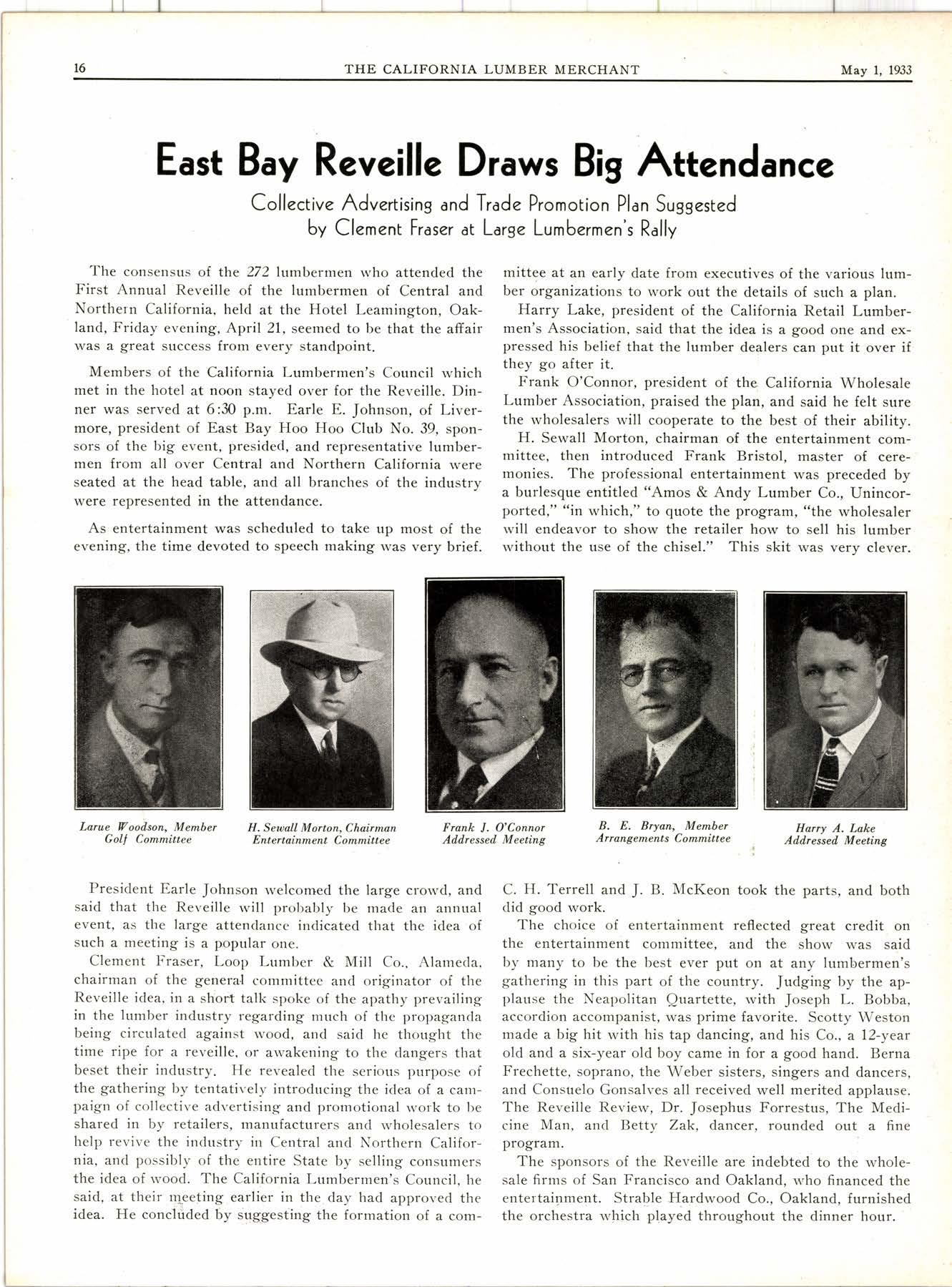
3 minute read
Lumber Market Prospects For 1933
Washington, April l8.-Writing to Col. W. B. Greeley. Manager of the West Coast Lumbermen's Association, at Seattle, Wilson Compton, Manager of the National Lumber Manufacturers Association, gives it as his opinion that the recent increase in lumbi:r shipments is clearly not due to any expansion of lumber consumption. It is due, rather, Dr. Compton says, to the conviction of buyers that lumber prices have reached such a lorv point that buying now is considered prudent, the more so as it is generally knorvn that lumber stocks at the mills have been reduced to manageable proportions.
The letter rvas written in response to one from Col. Greeley asking Dr. Compton's viels in regard to rnarket prospects in view of the present buying wave and also to the possibilities for closer and more effective cooperation in the lumber industry growing out of the supreme court decision in the Appalachian Coals case.
The prospect of credit or monetary inflation is also a factor Dr. Compton finds in the general business situation which must be taken into account in considering the recent spurt in lumber buying. Inflation would result in higher coinmodity prices, but in any event "if lumber production is kept in control, there is reason to expect further continued rebound in prices." Dr. Compton presents the inflation prospect as follows:
The Possibilities of Inflation
"The fact that we have gone off the gold standard-although as yet only technically and not far-has given grounds for this view. There will be more inflation. The only question is the form and manner and as to that nobody knows yet, neither the Administration, Congress or the people. Currency inflation ma;r of"course be offset by further credit deflation, such as that resulting from the bank moratorium. No one knows whether and to rvhat extent the inflationary matters rvill outbalance the deflationary.
"A huge public rvorks program is also in prospect. Administration advisers, both official and unofficial, are studying the possibilities of a gigantic undertaking with public funds to arrest the downward spiral and reverse its direction. Confident statement is privately made within the Administration that a well planned expenditure on public works of between five and six billion dollars, if properly related to private enterprise, rvould restore directly between two and two and one-half million to employment and indirectly from six to seven and one-half million more, a total of from eight to ten million. The theory is that one person returned to employment directly through the use of public funds rvould'within a few months carry three additional persons into employment throggh stimulated private industry. At any rate, the pfbbpect is for a gigantic effort to stimulate trade with the deliberate purpose of reversing the direction of the downvvard spiral. So far the action of the Administration has been toward further deflation and unless this trend is reversed, industry everywhere is going to be crucified. That the Administration knows and whether publicly stated or not, it is the greatest single cause of concern within the r\dministration and among the leaders in Congress
"Back of the recent spurt in lumber buying therefore is the conclusion that prospective inflation will result in higher commodity prices; that the lumber stocks are relatively low; and that the wise strategy of the dealer who has low stocks is to replenish them at these prices.
"If lumber production is kept in control, there is reason to expect further continued rebound in prices."
Lumber and the Appalachian Decision
On the subject of the Appalachian Coals decision, Dr. Compton says that "It puts organized cooperation among competitors on a par with mergers or consolidations of the same competitors."
"This means," he continues, "that so far as the federal larv is concerned lumber companies may do through cooperation between competitors what has long been established that they may lawfully do by a complete merger of ownerships. Furthermore, the Court has held that there is such a thing as a reasonable agreement affecting prices." There is thus opened up a vast field of cooperative action in production and distribution. The important practical factor so far as such trade agreements in the lumber industry are concerned, "is not a question of law but a question of the financial ability and the willingness of competitors to work together and to continue working together."
The most practical and useful cooperative means under the decision are held to be a common agency for handling sales and a common management plan for handling production or both production and sales. If the West Coast industry were to set up a sales agency arrangement comparable to that of Appalachian Coals, Inc., it might arrange a sales combination to handle, say,75/o of the 6r lumber based on production or on capacity; or a similar percentage for hemlock-possibly a combination of all West Coast wood. It would not, however, be advisable to attempt to secure any marketing advantages or results which would be dependent upon any monopoly element or upon an ability arbitrarily to determine conditions of trade or to influence prices. However, Dr. Compton considers that there is little danger of a monopoly question arising in lumber distribution because competitive forces in the lumber industry are so porverful that the most that can be hoped for at present is that destructive competition shall be substantially tempered. All that can be reasonably hoped for now (pending correction of certain basic conditions) is that thq device of cooperative selling will place sellers of lumber on a reasonable competitive parity .with buyers.











